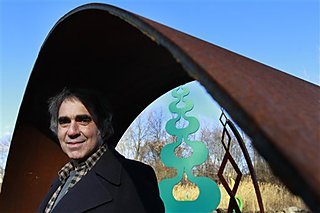Reuters
Jan 11, 2012
Artist weaves 20,000 feet of cord over Rhode Island river
Reuters
Jan 11, 2012
PAWTUCKET, Rhode Island - A textile mill built on a Rhode Island riverbank in the 1700s has inspired a new kind of weaving: 20,000 feet of colorful synthetic cords, stretched across the water in an enormous art installation.
 Photo: AP |
A local artist erected "Weaving the Blackstone" over the churning waters of the Blackstone River, which once powered Slater Mill in Pawtucket, birthplace of the American Industrial Revolution.
The huge artwork of green, red, yellow and blue cables was intended to celebrate Slater Mill, the country's first successful textile mill, and help establish a new standard for public art, said the artist, Donald Gerola.
"I had the vision," said Gerola, 62, who recalled thinking, "I'm going to do this beautiful thing across the river."
To build the piece, Gerola cleared more than 100 trees along the river's banks and hired two archers to shoot arrows across the water with filaments attached. The filaments were then used to pull larger cords across the water, he said.
About 30,000 feet of cord was used to create the installation, some of it made by a local textile company, Neocorp, Gerola said.
Vandals twice cut sections of cable while Gerola and others were building the piece, which was completed in late December.
"Weeks of work gone, down, finished," he recalled in an interview this week with Reuters.
The colorful cables are held together by bars meant to resemble the heddles of a loom. They criss-cross the river at various angles, forming triangles and other shapes that seem to hover above the water in the glow of spotlights at night.
"It's visually stunning at really all hours of the day, but especially at night when it's illuminated," said John Baxter, Jr., chairman of the Pawtucket Arts Festival, which provided initial funding for the project.
The installation reflects the city's industrial past and its transition into an arts community, he said.
Pawtucket, a hardscrabble city of about 72,000 people, several years ago established an arts district and provides tax breaks for artists, said Michael Davolio, the city's director of planning and redevelopment.
Old mill buildings have been converted into studios and the city has become home to a range of artists, from painters to filmmakers, but "we still have a lot of work ahead of us," Davolio said.
The Blackstone River has been recognized for its historical significance by the National Park Service, and the city has sought to turn the mill and the surrounding area into a national park, he said.
Today Slater Mill consists of a museum complex that includes the original mill, which was built in 1793 and produced cotton thread exclusively until 1829.
Gerola said the museum was planning to use a refurbished bobbin spinner from the 1860s to spin a cable that will be added to his installation, perhaps during an opening ceremony.
The project was funded with $22,000 from a local printing company, but Gerola said it operated at a financial loss given the time and resources it required.
"I wanted to do it at any expense, no matter how much the loss was, because it was never done before," he said.
By Daniel Lovering
(Editing by Barbara Goldberg and Paul Thomasch)
© Thomson Reuters 2024 All rights reserved.

























